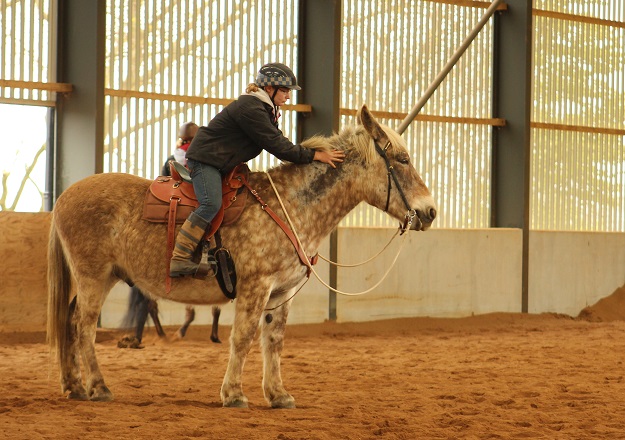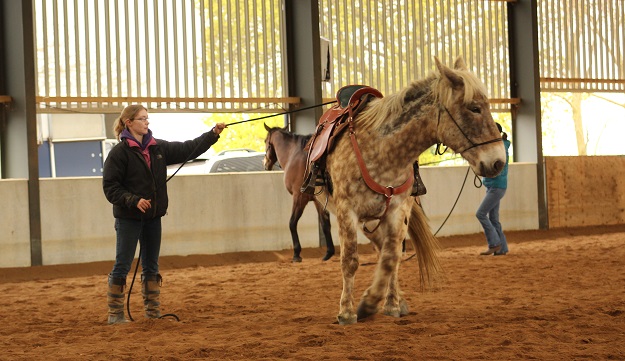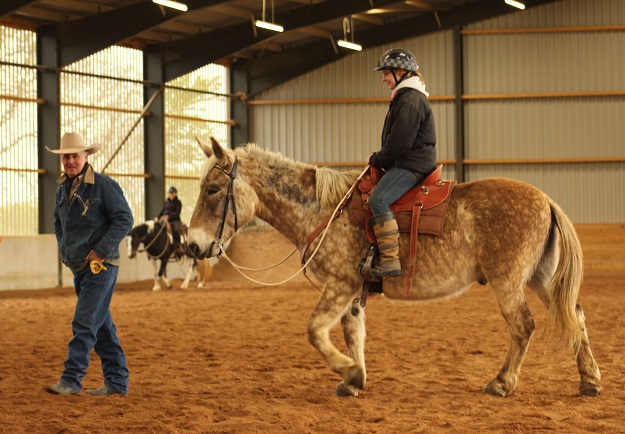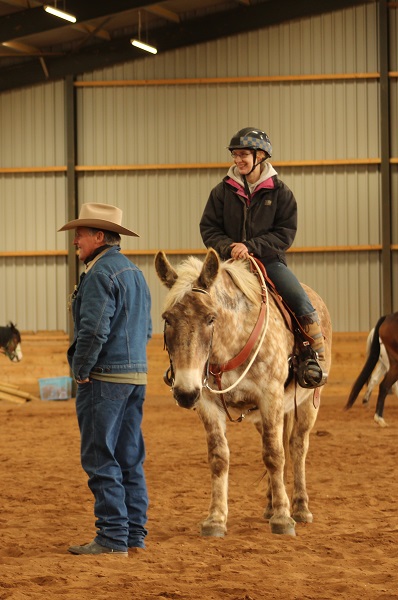Xato and the Joe Wolter Clinic
Part Three: Three Things I Learnt By Riding With Joe
Back in April 2017, Ben and I took our Practical Animals (aka Iris and Xato) down to Devon in order to ride with Joe Wolter. It was Joe’s first clinic in the UK and it was an opportunity we did not want to miss. Joe is a superb horseman and he also knows mules, which was really my main motivation for going as it’s quite rare to find trainers with mule experience in the UK.
In June of the same year I finally made a start at writing up our clinic trip by recounting our disastrous attempts to get there, and then later in the month I followed up by talking about the things we learned on day one. After that, we just have tumbleweed; but with Joe back again at the beginning of August, I felt like I really needed to pull my finger out and get the 2017 write-up finished.
By this point I’ve forgotten a lot of the minutiae of the clinic, so I’m just going to share three of the big lightbulb moments I had while we there.
1. Go with the mule so the mule can go with you.
This was the big one; the idea that, instead of trying to block an unwanted behaviour, you go with it and then turn the mule or horse’s idea into your own. For example, imagine that you are riding along and your mule spooks right. For me, my immediate reaction would be to try and block it (you may be a much better rider than me, of course!); I would want to take up my left rein and apply my right leg. Joe’s suggestion, however, is to take what the mule offers you and direct it. Instead of trying to block him with your left rein, you would pick up on the right rein and bring him round in the direction he’s already travelling. “If the horse (or mule) doesn’t feel like he is trapped or confined, if he feels like he can move, then I can get with his movement and just try to direct it,” Joe said. “It leads to a better feeling from the horse towards me, and I’m not so abrasive – I’m not so confrontational.”
By shutting down their movement, we are taking away their self-preservation. This is not going to create a harmonious relationship and, with something like a mule for whom the ability to trust and depend upon his rider is paramount, it’s going to lead to some bad situations. It took me some time to get my head around this because it’s so ingrained – particularly for someone like me, who has a bit of a phobia about being bolted with. I’m still struggling to get my head around this and overcome the muscle memory that wants me to grab the reins and pull the plug. But when you think about it, it makes so much sense.
Giving up control – or what we perceive as control – is hard, really hard. By working with them rather than against them, we help to install the feeling that going with us is a good decision. When they know that they can move their feet if they want to, they are actually less likely to do so. This is something I learnt with Anna but I definitely needed to be reminded of it again, because I am a colossal idiot.
2. Ask for something you know you can get.
Essentially: if you’re having trouble, go back to something you know your mule can do easily. They gain confidence from completing the task and understanding what’s being asked of them, and you can then go back to the more difficult exercise. To add to this, I have also realised that the same method is true for people. If you’re a timid rider, don’t force yourself to ride past the “scary” corner or through the open field right away – when you’re struggling with your nerves, do something you know you and your mule can do without fear and then go back to the other thing later. You will both benefit from this.
3. “It’s not training – it’s a series of puzzles.”
Again, this was further reaffirmation of something I learnt with Anna, and with Harry Whitney before her. This is one of the reasons why I believe in learning with as many different trainers as possible, because very often they are teaching the same thing but from different angles. Something you learnt and thought you understood with one trainer may take on a whole new layer of understanding when explained by another. Plus, if you’re anything like me, it helps to be reminded of things which you may have known but forgot that you knew…!
Rather than approaching it as training, we should be attempting to ignite the mule’s curiosity and ability to think for himself. By presenting him with a series of puzzles to figure out, he learns by discovery rather than being told what to think. This is easier to retain and creates a more willing, confident mule. When we interviewed Joe and spoke about this, Ben summed it up by saying: “By developing the curiosity more, they won’t need to get to where the self-preservation comes in because you allowed them to figure it out.”




A moment from the clinic that I do remember with great clarity is when I finally got on board. I had spent the previous two days doing groundwork, trying to psyche myself up to “just getting on” but being unable to do it. On the evening of the second day, Ben and I went to dinner with Xato’s Real Mum Xanthe who had flown over to spectate. Xanthe pointed out rather sensibly that I needed to get back on at some point, and it may as well be here with one of the best horsemen in the world there to help me.
I don’t know whether Joe understood how nervous I was or whether James, the clinic organiser, had said something to him – or maybe it’s just that Joe is, by nature, an incredibly kind and genuine man. He asked if I wanted to get on in the round pen, which was outside the arena and would have taken him away briefly from the other riders; when I declined, he asked if I wanted him to put me on a lead-line. Not anyone else, him. Can you imagine? A horseman of his calibre leading me around like a kid on a school pony! The important thing here was that there was absolutely nothing patronising about the way he asked. He knew it might help and so he was offering.
I turned down the lead-line, but the offer left such an impression on me that I immediately felt like I could do this. Joe had also asked if the other riders could dismount and wait for a few minutes – I don’t know if I’d voiced my irrational fears about Xato running off and causing mayhem to anyone, but Joe seemed to understand. With the riders on the ground I felt like even if the worst happened, they’d be safe; and so I was able to put that worry aside. I was briefly embarrassed and worried that they would be cross with me for taking up Joe’s time, but they were such a wonderful group of people and I quickly realised that they wanted to help. Each one of us would have done the same for each other.
Once on board and settled, Joe went for a stroll and invited Xato to come with him. We wandered around like this for a bit before Joe asked me to work on getting Xato to follow the feel of a direct rein. He then asked the other riders to start leading their horses around the perimeter of the arena and for me and Xato to go with them. This helped both of us because I wasn’t worrying about where he’d go.
The riders remounted, and we continued with the session. At one point Joe asked us to dismount while he worked on an individual issue, and afterwards I got back on by myself without prompting. This sounds ridiculous, but I was very pleased with myself.
After the clinic, Xato and I embarked on a wonderful summer of hitting the trails and going riding with friends. It was brilliant fun and a shame that things then went badly going into winter and I lost my confidence for a second time. For a while I was quite ashamed, as people had been so nice to me and Joe had been such a fantastic teacher, so I felt like I’d wasted everyone’s time. This is untrue, of course. Everything I learnt on the clinic has huge value and I’ve been gleaning more and more insight from it while I’ve been working through this latest bout of anxiety. With Xato receiving tuition from Ben, I feel ready to start applying what I’ve learnt and getting better.

We’re not riding on this year’s clinic, but we’re going along to spectate anyway. It is at the Crescent Arena, Kentisbeare, Devon, from the 3rd-5th August. You can find more details here. Maybe we’ll see you there?
